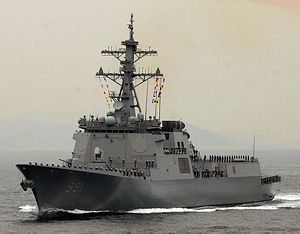When it comes to understanding emerging military technologies, and the geopolitical implications that flow from them, few can top the analysis of Second Line of Defense.
A case in point is understanding the synergy of the Aegis combat system and the F-35 in the Asia-Pacific. For years now, Second of Line of Defense analysts have emphasized how the interaction between the F-35 and the Aegis combat system would greatly enhance U.S. and allied military power in the region. For example, in the January 2012 issue of Proceedings Magazine, Robin Laird, SLD co-founder and friend of The Diplomat, noted that the Aegis would serve as the “wingman” for F-35 pilots. As Laird explained:
Upcoming tests will support a launch/engage-on-remote concept that links the Aegis ship to remote sensor data, increasing the coverage area and responsiveness. Once this capability is fully developed, SM-3 missiles––no longer constrained by the range of Aegis radar to detect an incoming missile––can be launched sooner and therefore fly farther to defeat the threat.
Imagine this capability linked to an F-35, which can see more than 800 miles throughout a 360-degree approach. U.S. allies are excited about the linkage prospects and the joint evolution of two highly upgradable weapon systems. Combining Aegis with the F-35 means joining their sensors for wide-area coverage.
In other words, the superior ISR capabilities of the F-35 will be used to enhance the Aegis combat system’s effectiveness. That’s because data collected by F-35s would be sent back to Aegis-equipped vessels out at sea, which would use their missile and missile defense capabilities to greater effect. This capability would be especially potent in dealing with China’s land-based missile and anti-ship missile systems, especially when combined with the F-35’s electronic and cyber capabilities.
As a result, Laird predicted that America’s Pacific allies that are part of the Aegis network would become customers of the F-35. That prediction has proven to be amazingly prescient.
Besides the United States, three nations in the Asia-Pacific currently use or are in the process of building Aegis-equipped vessels. In Japan, the Maritime Self Defense Forces’ (MSDF) Kongō-class destroyers and the Atago-class guided missile destroyers—themselves an updated version of the Kongō-class—employ Aegis combat systems. South Korea’s Navy also employs Aegis systems on their KD-III (Sejong the Great-class) destroyers. And the Hobart-class air warfare destroyers that the Royal Australian Navy is currently building will be equipped with the Aegis combat system.
Notably, the same three countries are also the only ones in the Asia-Pacific that have committed to the Joint Strike Fighter program, although other Southeast Asian nations and possibly Taiwan could purchase F-35s in the future. In 2011, Japan committed to purchasing the F-35 as part of its F-X program to replace its aging F-4 aircraft fleet. Although the actual number of F-35s that Japan will buy remains uncertain, the aircraft is already being integrated into its national security strategy.
Earlier this year, South Korea also officially announced it will purchase at least 40 F-35 JSFs for its FX-III program, beating out Boeing’s F-15SE and Eurofighter’s Typhoon. And while Australia was one of the founding members of the Joint Strike Fighter program, and agreed to purchase 14 F-35s in 2009, it went “all in” on the aircraft earlier this year when Prime Minister Tony Abbott announced Australia would purchase at least another 58 F-35s.
Both the Aegis and the Joint Strike Fighter, as well as the interaction between them, demonstrate how America is using military technology to strengthen its worldwide network of alliances. To begin with, the programs are both designed to strengthen the economic interdependence of America’s allies across the globe, with each nation utilizing comparative advantages in producing various parts for the Aegis and JSF, as well as further innovating them.
At the same time, systems like the F-35 and Aegis inherently foster greater interoperability between militaries that use them. This will be especially important for the U.S. in the Asia-Pacific, which currently lacks the kind of collective security mechanisms found in Europe or even the Persian Gulf. Although military systems like the F-35 and Aegis won’t be as effective in integrating regional defense as an organization like NATO, they should help prevent the kind of disasters seen at the Battle of Java should the U.S. and its allies ever find themselves fighting together in an actual conflict.

































